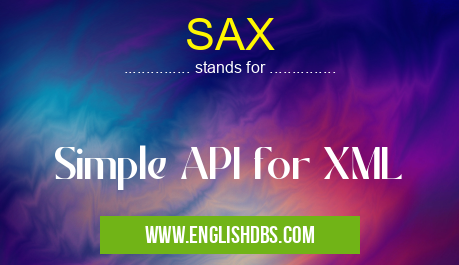What does SAX mean in GENERAL
SAX stands for Simple API for XML. XML, which stands for Extensible Markup Language, is a computer language that helps developers create data documents. SAX is an application programming interface (API) that helps developers parse data from an XML format into another readable form such as JSON or HTML. It works similarly to a document reader, looping through each item in the XML document and extracting its contents.

SAX meaning in General in Computing
SAX mostly used in an acronym General in Category Computing that means Simple API for XML
Shorthand: SAX,
Full Form: Simple API for XML
For more information of "Simple API for XML", see the section below.
Definition of SAX
SAX (Simple API for XML) is an event-based application programming interface (API) used to read and parse text files written in an Extensible Markup Language (XML). The API enables processing streamed data by breaking it up into chunks that are identified by special tags. This allows for the efficient parsing of large amounts of structured data stored in XML. Instead of loading the entire file into memory, the API reads and processes only specific pieces of information from within the file when they are needed.
Advantages of Using SAX
Using SAX has several advantages compared to other methods of parsing data from an XML document. Firstly, because it only reads what it needs at any given time rather than bringing everything into memory at once, it’s more efficient than alternative options like DOM which process all items at once and require more resources to do so. Additionally, because SAX works linearly, it generally produces faster results than DOM-style parsers which have to traverse complicated hierarchies of nested elements in order to find the desired data.
Essential Questions and Answers on Simple API for XML in "COMPUTING»GENERALCOMP"
What is SAX?
SAX (Simple API for XML) is an event-driven, stream-oriented, push-parsing API provided by the JDK for efficiently parsing XML data. It enables developers to apply custom logic to an XML document as it is read sequentially from start to finish. Because of its event-driven approach and memory efficiency, it is often used when parsing large amounts of XML data or complex documents.
How does SAX work?
SAX operates by first creating a Parser object which reads the characters in the source code one at a time. As it encounters different elements within the XML document, it will trigger certain events which can be handled with custom code written by the user. By leveraging these events, you can process elements according to your own logic which allows you to create powerful functionality with minimal effort.
What are some advantages of using SAX?
There are several benefits of utilizing SAX for parsing XML documents including improved performance and memory efficiency due to its event-driven approach as well as allowing developers to create advanced logic through custom code written with the API. Additionally, since SAX parses data quickly by passing through each character one at a time without doing any extra work, it prevents potential performance issues that may arise if a DOM parser had to build up an entire tree structure before traversing it.
Is there anything wrong with using SAX for parsing XML documents?
While there are many positives associated with using SAX for parsing XML data, there are also some drawbacks that should be taken into consideration before making the decision on which parser to use. The main disadvantage of SAX is its lack of support for document modification, so if you plan on editing your XML document during processing then another parser such as DOM might be a better choice.
Why should I choose DOM over SAX when editing an existing XML document?
When considering whether or not to use DOM instead of SAX when working with existing XML documents, you should consider how much control over structural changes within the file you need. Due to its ability store each element in a tree structure while loading the entire content into memory upfront, DOM provides more control over modifications than what is offered by SAX's linear approach while still providing efficient performance compared to other parsing techniques.
Will I see improved performance when using DOM instead of SAX?
The primary advantage that comes from using DOM instead of SAX when dealing with large or complex documents is increased control over structural changes within the file which can be beneficial in certain circumstances but also comes at a cost. Generally speaking though, since DOM does not build up an entire tree structure before traversing it like some other parsers do , it tends offer relatively efficient performance even when loading large resources into memory.
Should I use both DOM and SAX together in my application?
In most cases it is recommended that one parser type either be chosen exclusively for all tasks or multiple parsers being used together depending on what kind of project you are creating and how complicated your requirements are. Combining both DOM and SAX can provide great flexibility in terms of having multiple possible avenues available while ensuring optimal performance due to their complimentary approaches.
Final Words:
In computing terminology, SAX stands for Simple API for XML and provides developers with an efficient way to parse and extract information from large commercial datasets stored in an XML format without having to load them entirely into memory first. By working line-by-line and only extracting specific pieces of information when needed, developers can save time and resources while still getting access to critical business intelligence when required for their applications.
